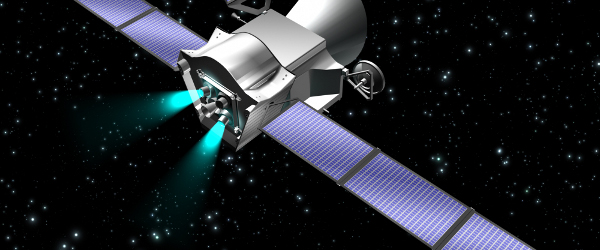
The European Space Agency (ESA) has announced that it will develop a new generation of satellites propelled by solar electric thrusters, following the signing of a contract with SES of Luxembourg for the next phase of the Electra project.
Electra is a partnership between ESA and satellite operator SES to define, develop and validate in space an electric-only propulsion platform for geostationary telecommunication satellites.
The first launch is expected by the end of 2018.
Electra is the first partnership project established under ESA’s ARTES-33 programme, which supports market-driven innovations from industry that require flight heritage and in-orbit validation – proof that they work in space – so that they are more readily embraced by the marketplace.
Through Electra, Europe’s new capability will serve the current and future needs of satellite operators in the geostationary segment for smaller satellites.
The use of electric-only propulsion for orbit raising and stationkeeping brings important savings in fuel consumption, reducing launch mass by 40%. This allows payloads to be twice as large or the use of smaller launch vehicles.
German satellite builder OHB Systems is in partnership with SES for the development of Electra. OHB aims to extend its portfolio of telecom satellite platforms, adding a fully electric version to the Small GEO product line with Electra.
The Electra project encompasses both the development of the platform and the flight of a mission defined by the satellite operator. The mission will be selected at the end of this Phase-B1 in 2014.
Jean-Jacques Dordain, ESA’s director general, attending the signing of the contract at SES in Luxembourg, noted: "Electra represents three partnerships in one: between SES and OHB, to develop the best solution for SES and the future needs of other satellite operators; between SES and ESA, to offer the best possible validation in orbit of a new technology; and between ESA and DLR to capitalise on previous investments. These three partnerships is the best way to optimise the use of public and private funds for enhancing the competitiveness of the European sector."
Rolf Densing, director of ESA Space Programmes at the DLR German Aerospace Center, said: "Electra is a good example of the kind of cooperation we are seeking with ESA in the area of telecommunications. It maximises the outcome for German industry in terms of potential commercial exploitation.
"At the same time, Electra imposes a rigorous framework on all the parties involved, derived from the high commercial stakes. With Electra we continue our strategy to establish a prime for small telecommunication satellites in Germany."
Magali Vaissiere, ESA’s director of Telecommunication and Integrated Applications, added, "We are adapting our tools to best support the competitiveness of our satellite telecommunication industry.
"Electra is the first example of our Partner programme, where we are consolidating the model of partnerships with the private sector to help the introduction and adoption of innovative efficient solutions proposed by our industry.
"SES is not only a world-leading satellite operator but also a key reference for the consolidation of OHB as a prime contractor in the commercial satcom sector."


